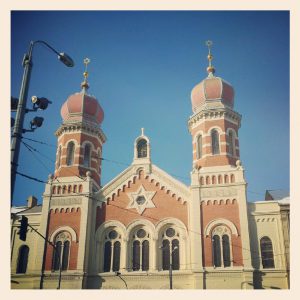The Great Synagogue in Pilsen
By Tracy A. Burns
 Tourists flock to the Jewish Town in Prague to see the synagogues, but there are plenty of Jewish sights outside of the capital that deserves attention as well. Built in 1892, the Great Synagogue in western Bohemia’s Pilsen (Plzen in Czech) is the largest synagogue in the Czech Republic, the second largest in Europe, and the third-largest in the world with a capacity of over 2,500 worshippers. The history of Jews in Pilsen is fascinating, too.
Tourists flock to the Jewish Town in Prague to see the synagogues, but there are plenty of Jewish sights outside of the capital that deserves attention as well. Built in 1892, the Great Synagogue in western Bohemia’s Pilsen (Plzen in Czech) is the largest synagogue in the Czech Republic, the second largest in Europe, and the third-largest in the world with a capacity of over 2,500 worshippers. The history of Jews in Pilsen is fascinating, too.
The architectural plans
Viennese architect Max Fleischer designed the original plan for the synagogue, allowing for two 65-meter high towers and buttresses in Gothic style, but his design was not carried out. Pilsen residents did not want the synagogue to be more captivating than the Cathedral of Saint Bartholomew on the main square. The plans of Emmanuel Klotz, though, were put into effect, and the synagogue opened its doors to the town’s 2,000 Jews in 1893. The towers were made less imposing by lowering them by 20 meters, though the ground plan was the same.
The exterior and interior
The style of the synagogue is eclectic, described as Moorish-Romanesque Revival. A large Star of David dominates the façade. The synagogue even sports a Russian Orthodox look with its onion domes. Oriental ornamentation punctuates the interior, and the ceiling has an Arabic flavor. There are also Romantic and Neo-Renaissance elements. The structure boasts three aisles and many paintings with plant motifs. The painting above the altar is stunning as it is richly decorated with plant motifs in blue and gold. There are three exquisite stained glass windows and a vestibule that features partially gilded rich stucco adornment. The organ dates from 1890. The rostrum is masterfully carved. The winter prayer room, still used for services today, boasts richly decorated paintings with plant motifs, too.
The history of Jews in Pilsen
It all began in the 13th century when Jews first came to this city, and Bohemian King Premysl Otakar II granted them religious freedom. At the beginning of the 15th century, most Jews bartered in spices, pepper, and ginger. At that time two synagogues existed in Pilsen. King Vladislav II made some drastic changes, however. Jews were expelled from the town. They did not return until 1584.
A new beginning
During the middle of the 19th century, life looked rosier for the Jewish community. In 1848 many anti-Jewish measures were canceled. From 1848 to 1849 Jews no longer had to pay special taxes. Finally, in 1867, a new constitution gave Jews political and religious equality, allowing them to move as they pleased and to own property. They were even offered state citizenship. Jews from both Bohemia and Moravia flocked to Pilsen in the 1860s. They mostly worked in the tanning industry, the paper industry, the distilling industry, and the iron and steel industry. Jews also became clothing manufacturers. The Jewish community of this town thrived during the 19th and beginning of the 20th centuries as Jews managed influential businesses in the city.
Tough times
During the Nazi Occupation, the synagogue was used as a warehouse, so it was not destroyed. After World War II the synagogue was returned to the Jewish community, but the last regular service took place in 1973 because the building had become so dilapidated. Finally, it was closed down.
Reconstruction
Reconstruction occurred from 1995 to 1997, and the synagogue reopened on February 11, 1998. A service was held there again, for the first time in 26 years, on September 20, 1998, to celebrate the Jewish New Year. Now the synagogue often hosts concerts, and photographic exhibitions line the walls. Currently, there are only about 70 Jews in Pilsen.



